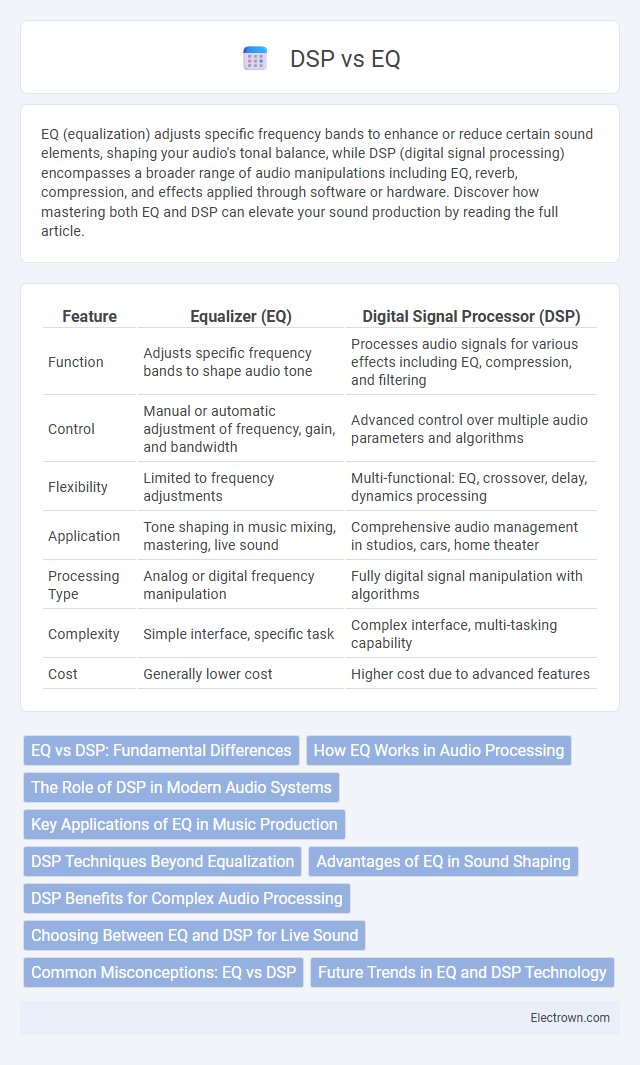EQ (equalization) adjusts specific frequency bands to enhance or reduce certain sound elements, shaping your audio's tonal balance, while DSP (digital signal processing) encompasses a broader range of audio manipulations including EQ, reverb, compression, and effects applied through software or hardware. Discover how mastering both EQ and DSP can elevate your sound production by reading the full article.
Table of Comparison
| Feature | Equalizer (EQ) | Digital Signal Processor (DSP) |
|---|---|---|
| Function | Adjusts specific frequency bands to shape audio tone | Processes audio signals for various effects including EQ, compression, and filtering |
| Control | Manual or automatic adjustment of frequency, gain, and bandwidth | Advanced control over multiple audio parameters and algorithms |
| Flexibility | Limited to frequency adjustments | Multi-functional: EQ, crossover, delay, dynamics processing |
| Application | Tone shaping in music mixing, mastering, live sound | Comprehensive audio management in studios, cars, home theater |
| Processing Type | Analog or digital frequency manipulation | Fully digital signal manipulation with algorithms |
| Complexity | Simple interface, specific task | Complex interface, multi-tasking capability |
| Cost | Generally lower cost | Higher cost due to advanced features |
EQ vs DSP: Fundamental Differences
EQ modifies specific frequency bands in your audio signal to enhance or reduce certain tones, providing precise tonal balance. DSP encompasses a broader range of processing techniques, including EQ, compression, reverb, and noise reduction, to manipulate and improve overall sound quality. Understanding the fundamental differences helps you choose the right tool for targeted frequency adjustment or comprehensive audio enhancement.
How EQ Works in Audio Processing
EQ works by adjusting the amplitude of specific frequency bands within an audio signal to enhance or reduce certain sounds. It uses filters such as bell, shelf, and notch to target frequencies precisely, shaping the tonal balance of the audio. Unlike DSP, which can include a wide range of effects and processes, EQ specifically fine-tunes frequency response for clarity and definition.
The Role of DSP in Modern Audio Systems
Digital Signal Processing (DSP) plays a crucial role in modern audio systems by enabling precise manipulation of audio signals beyond traditional Equalization (EQ) capabilities. Unlike static EQ filters, DSP offers dynamic adjustments, adaptive filtering, and complex algorithms such as noise reduction, echo cancellation, and spatial audio enhancement. This flexibility allows audio engineers to achieve superior sound quality, optimize system performance, and tailor audio experiences to varied environments and listener preferences.
Key Applications of EQ in Music Production
EQ is essential for shaping the tonal balance of individual tracks by boosting or cutting specific frequency ranges, enabling clearer separation of instruments in a mix. It excels in correcting problematic frequencies like muddiness or harshness to enhance overall sound quality. Your music production benefits from precise EQ adjustments that create a polished, professional-sounding final mix.
DSP Techniques Beyond Equalization
Digital Signal Processing (DSP) techniques extend far beyond basic equalization by incorporating advanced methods such as dynamic range compression, noise reduction, and spatial audio processing. These techniques enhance audio clarity, reduce unwanted sounds, and create immersive listening experiences that simple equalizers cannot achieve. Understanding how DSP manipulates audio signals allows you to optimize sound quality effectively across various applications.
Advantages of EQ in Sound Shaping
Equalizers (EQ) allow precise frequency adjustment, enabling tailored sound shaping to enhance clarity and tonal balance in audio production. They provide control over specific frequency bands, making it possible to cut unwanted noise or boost desirable frequencies for a cleaner mix. EQ's simplicity and intuitive interface make it ideal for quick sound corrections compared to more complex DSP processing chains.
DSP Benefits for Complex Audio Processing
DSP offers superior benefits for complex audio processing by enabling real-time manipulation of multiple audio parameters with high precision and flexibility. Unlike traditional EQ, DSP can implement advanced algorithms such as dynamic range compression, noise reduction, and spatial audio effects seamlessly. Your audio experience improves significantly as DSP provides dynamic adjustments that adapt to varying sound environments for optimal clarity and fidelity.
Choosing Between EQ and DSP for Live Sound
Choosing between EQ and DSP for live sound depends on your specific needs for audio control and customization. EQ (Equalization) adjusts frequency balance to enhance clarity and reduce feedback, making it essential for fine-tuning vocals and instruments in real time. DSP (Digital Signal Processing) offers advanced capabilities like dynamic range compression, reverb, and noise reduction, providing comprehensive sound management that adapts to complex live environments and ensures your mix remains consistent and professional.
Common Misconceptions: EQ vs DSP
Common misconceptions about EQ and DSP often confuse their distinct roles in audio processing. EQ specifically adjusts frequency bands to shape tonal balance, while DSP encompasses a broader range of effects including compression, reverb, and delay beyond simple frequency adjustments. Understanding that EQ is a subset of DSP helps clarify that DSP offers comprehensive tools for enhancing sound beyond mere equalization.
Future Trends in EQ and DSP Technology
Future trends in EQ and DSP technology emphasize AI-driven adaptive algorithms that analyze acoustic environments in real time for precise sound customization. Integration of machine learning enhances automatic audio correction, enabling more intuitive user interfaces and personalized sound profiles. Advances in DSP hardware support higher processing power at lower latencies, facilitating immersive audio experiences like spatial sound and augmented reality applications.
eq vs dsp Infographic

 electrown.com
electrown.com